Varied difficulty levels in AP Inter 1st Year Zoology Model Papers and AP Inter 1st Year Zoology Question Paper May 2018 cater to students with diverse academic strengths and challenges.
AP Inter 1st Year Zoology Question Paper May 2018
Time: 3 Hours
Max. Marks: 60
Note: Read the following instructions carefully.
- Answer All the questions of Section A’. Answer any SIX questions in Section ‘B’ and answer any TWO questions in Section ‘C’.
- In Section A’, questions from SI. No. 1 to 10 are of very short answer types. Each question carries IWO marks. Every answer may be limited to 5 lines. Answer all these questions at one place in the same order.
- In Section ‘B’, questions from SI. No. 11 to 18 are of short answer type. Each question carries FOUR marks. Every answer may be limited to 20 lines.
- In Section ‘C’, questions from SI. Nos. 19 to 21 are of long answer type. Each question carries EIGHT marks. Every answer may be limited to 60 lines.
- Draw labelled diagrams wherever necessary for questions in Sections ‘B’ and C
Section – A
10 x 2 = 20
Note: Answer All the questions in 5 lines each:
Question 1.
What is biogenesis?
Answer:
The life comes only from life is called biogenesis. Living organisms produce young ones of their kind using molecules of heredity.
Question 2.
What is monaxial heteropolar symmetry? Name the group of animals in which it is the principal symmetry.
Answer:
Monaxial heteropolar symmetry: When any plane passing through the central axis of the body divides an organism into two identical parts is called Monaxial heteropolar symmetry or radial symmetry. It is the principal symmetry of the diploblastic animals such as Cnidarians and ctenophores.
Question 3.
Distinguish between exocrine and endocrine glands with examples.
Answer:
Exocrine glands are provided with ducts. Secrete mucus, saliva, earwax, oil, milk, digestive enzymes and other cell products. Endocrine glands are ductless and their products are hormones which are not sent out via ducts but are carried to the target organs by blood. Ex: Pitutoiy gland.
Question 4.
What is a Sesamoid bone? Give an example.
Answer:
Sesarnoid bones are formed by ossification in tendons. Eg: Patella (Knee cap) and Pisiform bone of the wrist of a mammal.
![]()
Question 5.
What is metagenesis ? AnimaIs belonging to which phylum exhibit metagenesis?
Answer:
Cnidarians show two basic body forms called polyp and medusa. Cnidarians which exist in both forms exhibit alternation of generations called meto gekiesis.
Question 6.
What are claspers? Which group of fishes possesses them?
Answer:
Claspers are formed from the posterior portion of pelvic fins in male cartilaginous fish. They serve as intermittent organs used to channel semen into the female’s cloaca during mating. Ex: Chondrichthyes fishes posseses Cias pers.
Question 7.
Draw a labelled diagram of the T.S. of flagellum.
Answer:
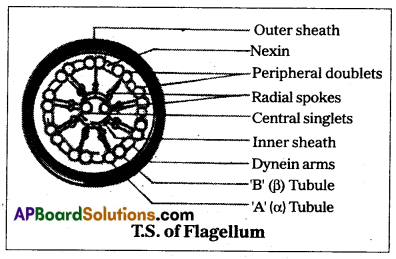
Question 8.
Distinguish between Proter and Opisthe.
Answer:
During transverse binary fission in Paramecium two daughter individuals are formed. The anterior one is called proter and the posterior is called opisthe.
Question 9.
Define parasitism and justify this term.
Answer:
An intimate association between two organisms of different species in which ‘one is benefited and the other one is often
adversely affected’ is called parasitism. The word parasitism comes from a Greek word parasitos’ (Para-at the side of:
Sitos – food or grain) which means one eating at another one’s table.
Question 10.
What is BOD?
Answer:
An increase in the concentration of the pollutant (or) toxicant at successive trophic levels in an aquatic food chain is called Bio-magnification.
Section – B
6 x 4 = 24
Note: Answer any SIX questions in 20 lines.
Question 11.
What is the evil quartet?
Answer:
Phylogenetic classification is an evolutionary classification based on how a common ancestry was shared. Cladistic classification summarizes the ‘genetic distance’ between all species in this Phylogenetic tree’. In Cladistic classification characters such as analogous characters (characters shared by a pair of organisms due to convergent evolution e.g. wings in sparrows and patagia (wing-like structures) in flying squirrels) and homologous characters (characters shared by a pair of organisms, inherited from a common ancestor e.g. wing of sparrows and finches) are taken into consideration. Ernst Haeckel introduced the method of representing Phylogeny by ‘tree’ branching diagrams.
Question 12.
Describe the three types of cartilage.
Answer:
Cartilage is a solid, but semi-rigid (flexible) connective tissue. Cartilage is of three types, which differ from each other chiefly in the composition of the matrix. Cartilage is a solid, but semi-rigid (flexible) connective tissue. It resists compression. Matrix is firm but somewhat pliable.
It has collagen fibres, elastic fibres (only in the elastic cartilage) and matrix-secreting cells called chondroblasts. These cells are enclosed in fluid-filled spaces called lacunae. Chondrocytes are the inactive cells of a cartilage. Cartilage is surrounded by a fibrous connective tissue sheath called perichondrium.
Cartilage is of three types, which differ from each other chiefly in the composition of the matrix.
1. Hyaline cartilage: It is bluish-white, translucent and glass-like cartilage. Matrix is homogeneous and shows delicate collagen fibres. It is the weakest and the most common type of all the cartilage, it is found in the walls of nose, larynx, trachea and bronchi.
2. Elastic cartilage: It is yellowish due to elastic fibres. Matrix has abundance of yellow elastic fibres in addition to collagen fibres. It provides strength and elasticity Perichondrium is present. It is found in the pinnae of the external ears, Eustachian tubes and epiglottis.
3. Fibrous cartilage: Matrix has bundles of collagen fibres. The perichondrium is absent. It is the strongest of all types of cartilages. It occurs in the intervertebral discs and pubic symphysis of the pelvis.
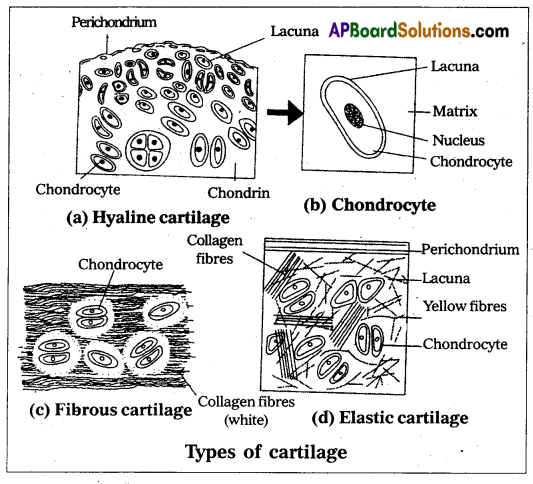
![]()
Question 13.
Compare briefly a centipede and a millipede.
Answer:
| Centipede | Millipede |
| 1. Centipedes are commonly called hundred Leggers. | 1. Millipedes are commonly called thousand leggers. |
| 2. Body is divided into head and trunk. | 2. Body is divided into head, thorax and abdomen. |
| 3. Centipedes are carnivorous in nature. | 3. Millipedes are herbivorous in nature. |
| 4. In each segment one pair of appendages are present. | 4. In each segment 2 pairs of appendages are present. |
| 5. Single genital aperture occurs at the posterior end of the trunk. | 5. Single genital aperture opens in the anterior part of the think. |
| 6. Head bears one pair of antennae, one pair of mandibles and two pairs of maxillae. Ex: Scolopendra. | 6. Head bears paired antennae, mandibles and maxillae. The maxillae are fused to form a plate-like under lip, the gnathochil – arium-a masticatory structure. Ex: Spirostreptus. |
Question 14.
Name the four ‘hallmarks’ of chordates and explain the principal function of each of them.
Answer:
The hail marks of chordates: All the chordates exhibit four fundamental characters. They are Notochoxd, Dorsal Wbukirnere cord, Pharyngeal slits or clefts and Post-anal tall.
Notochord: It is a flexible rod-like structure situated along the mid-dorsal line between the gut and the nerve cord. It is derived from the embryonic chorda mesoderm It is firm but flexible. It is present throughout the life in the lancelets and cyclostomes. It is present in tail of the tadpole larva of an ascidian.
It is present in embryonic stages. but is replaced partly or wholly by the vertebral column in the adults of higher chordates. Remnants of notochord occur as nuclei purpose in the intervertebral discs of mammals. Dorsal tubular nerve cord: A single, hollow tubular and fluid-filled nerve cord is situated above the notochord and below the dorsal body wall. It is derived from ectoderm of embryo. In the higher chordates, it gets enlarged to form a distinct brain at the anterior end the rest of it becomes the spinal cord.
Pharyngeal slits of clefts: These are slit opening present on the Pharyngeal wall and meant for the exit of the water from the pharyngeal cavity. They are present throughout the life in the proto-chordates, fishes and some amphibians. These are present in larval stages in amphibians. They develop by in-pushing of ectoderm and corresponding out pursing of the endoderm. In land vertebrates, the gills become vestigial and nonfunctional and are restricted to embryonic stages only.
Post-anal tall: Chordates have a tail extending posterior to the anus. It losts in many species during the late embryonic
development. It contains skeletal elements and muscles, coelom and visceral organs are absent in it.
Question 15.
Describe the process of longitudinal binary fission in Euglena.
Answer:
Binary fission is the most common method of asexual reproduction in protozoans. Longitudinal binary fission is performed by Euglerza. In this type of binary fission, the body divides into two halves longitudinally, hence called longitudinal binary fission.

During the process of binary fission, the nucleus, basal granules, chromatophores and cytoplasm undergo division. The nucleus divides by mitosis into two daughter nuclei. Then the kinetosomes and the chromatophores also divide. At first, a longitudinal groove develops in the middle of the anterior end.
This groove extends gradually towards the posterior end until the two daughter individuals are separated. One daughter Euglena retains the parental flagella. The other daughter Individual develops new flagella. From the newly formed basal granules. The stigma, para-flagellar body and contractile vacuole of the parent disappear. They develop afresh in both the daughter Euglenae. The longitudinal binary fission is known as symmetry rogenic division because the two daughters Euglenae resemble each other like ‘mirror images’.
Question 16.
What in adolescence is considered vulnerable phase?
Answer:
Adolescence: It is the time period between the beginning of puberty and the beginning of adulthood. In other words. It is the bridge linking childhood and adulthood. The age between 12-18 years is considered adolescence period. It is both a period and process during which a child becomes muture. It is accompanied by several biological and behavioural changes. Thus, adolescence is a very vulnerable phase of mental and psychological development of an individual.
Question 17.
Draw a neat labelled diagram of the mouth parts of cockroach.
Answer:

Question 18.
What is summer stratification? Explain.
Answer:
During summer in temperate lake, the density of the surface water decreases because of increase in its temperature (21-25°C). This ‘upper most warm layer of a lake is called epilimnion. Below the epilimnion there is a zone in which the temperature decreases at the rate of 1°C per meter in depth, and it is called thermocline or inetalimnion. The bottom layer is the hypolimnion, where water is relatively cool, stagnant and with low oxygen content (due to absence of photo synthetic activity).
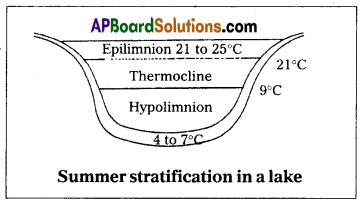
During autumn (also called fall). The epilimnion cools down, and the surface water becomes heavy when the temperature is 4°C and sinks to the bottom of the lake overturns bringing about ‘uniform temperature’ in lakes during that period, this circulation during the autumn is known as fall. The upper oxygen-rich water reaches the hypolimnion and the nutrient-rich bottom water comes to the surface. Thus there is uniform distribution of nutrients and oxygen in the lake.
![]()
Section – C
2 x 8 = 16
Note: Answer any TWO questions in 60 lines each:
Question 19.
Explain the structure of life cycle of Entamoeba histolytica with the help of neat and labelled diagrams.
Answer:
Entamoeba histolytica (Gr. entos – within amoeba – change histostissues; lysis – dissolve) is a microscopic and monogenetic parasite that inhabits the large intestine and causes amoebic dysentery or amoebiasis in man. It is cosmopolitan in distribution but more common in the tropical and subtropical regions of the world. It is common in the people of rural and densely populated urban areas wherever the hygienic conditions are poor.
Structure: Entamoeba histolytica passes through three distinct stages in its life cycle namely
i) Trophozoite stage
ii) Precystic stage &
iii) Cystic stage.
i) Trophozoit stage: It is the most active, motile, feeding and pathogenic stage that lives in the mucosa and submucosa membrane of the large intestine. It moves with the help of a lobo-podium which is pro-duced anteriorly.
The body of the trophozoite is surrounded by plasmalemma. its cytoplasm is differentiated into outer clear, viscous non-granular ectoplasm and inner fluid-like, granular endoplasm. Ribosornes, food vacuoles and vesicular, cartwheel-shaped nucleus are present in the endoplasm. The absence of mitochondria mdicates the obligate anaerobic nature of Entamoeba histolytica. It produces the proteolytic enzyme called histolysin due to which the species name histolytica was assigned to it. Due to the effect of this enzyme the mucosa and sub-mucosa of the gut wail are dissolved releasing some amount of blood, tissue debris which are ingested by the trophozoites. Hence the food vacuoles are with erythrocyte fragments of epithelial cells and bacteria. The presence of RBC in food vacuoles and cartwheel-shaped nucleus are the characteristic features of the trophozoites of Entamoeba histolytic.

ii) Pre-cystic stage: It is the non-feeding and non-pathogenic stage of Entamoeba histolytica that is found in the lumen of large intestine. It is a small, spherical or oval, non-motile form. The cytoplasm of the precystic stage stores glycogen granules and chromotoid bars (made of ribonucleoprotein) which act as reserve food.

iii) Cystic stage: It is round in shape and is surrounded by a thin, delicate and highly resistant cyst wall. It is found in the lumen of the large intestine.

The process of development of cyst wall is called encystation. Which is a means of tide over the un- favourable conditions that the parasite is going to encounter while passing to a new host. Soon after the encystation, the nucleus undergoes two successive mitotic divisions to form four daughter nuclei. This type of cystic stage is called tetra nucleate cyst or mature cyst which is the stage infective to man.
Life cycle : The trophozoites undergo binary fissions in the wall of the large intestine and produce a number of daughter
entamoeba. They feed upon the bacteria and the hosts tissue elements, grow in size and again multiply. After repeated binary fission. Some of the young ones enter of the lumen of the large intestine and transform into pre cystic stages. Here, the precystic stages transform into cystic stages. Which in turn develop into tetranucleate cysts. The entire process is completed only in a few hours.
These tetranucleate cysts come out along with the faecal matter and can remain alive for about 10 days. The cyst reach new host through contaminated food and water. In the small intestine of a new human host the cyst wall gets reptured releasing the tetra nucleate amoebae. Such tetra nucleate excystic amoebae are called metacysts.
The four nuclei of the metacyst undergo mitotic divisions and produce eight nuclei. Each nucleus gets a bit of the cytoplasm and thus eight daughter entamoebae or metacystic trophozoites are produced. These young ones develop into feeding stages called tro-phozoites. They invated the mucous membrane of the large intestine and grow into mature trophozoites.
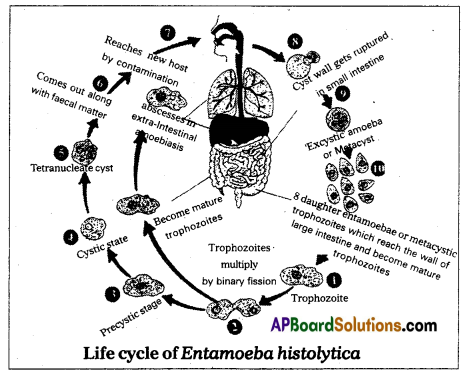
Question 20.
Describe the blood circulatory system of Periplaneta in detail and draw a neat and labelled diagram of it.
Answer:
The circulatory system helps in the transportation of digested food, hormones etc., from one part to another in the body. Peri-planeta has an open type of circulatory system as the blood or haemolymph, flows freely within the body cavity or haemocoel, Blood vessels are poorly developed and open into spaces. Visceral organs located in the haemocoel are bathed in the blood. The three main parts associated with the blood circulatory system of peri-planeta are the haemocoel, heart and blood.
Haemocoel: The haemocoel of cockroach is divided into three sinuses by two muscular, horizontal membranes called dorsal diaphragms or pericardial septum and ventral diaphragm. Both the diaphragms have pores. There is a series of paired triangular muscles called alary muscles. Every segment has one pair of these muscles situated on the lateral sides of the body.
These are attached to the pericardial septum by their broad bases and to the terga by their broad bases and to the terga by their pointed ends or apices. The three sinuses of the haemocoel are known as pericardial haemocoel or the dorsal sinus, the perivisceral haemocoel or the middle sinus and sternal haemocoel or ventral sinus or perineural sinus.
The middle sinus is very large as it contains most of the viscera. The dorsal and ventral sinuscs are small as they have only heart and nerve cord, respectively.
Heart: The heart lies in the pericardial haemocoel or dorsal sinus. It is a long muscular, contractile tube found a long the
mid dorsal line, beneath the terga of the thorax and abdomen.
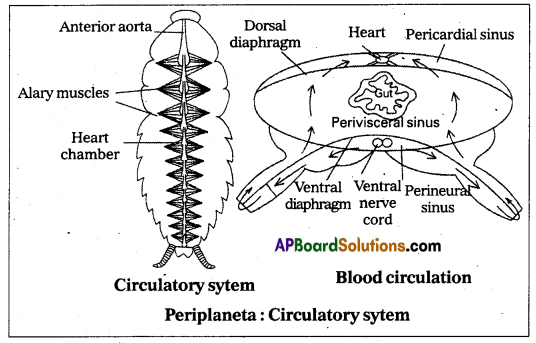
It consists of 13 chambers. Every chamber opens into the other present in front of it. Three of the thirteen chambers are situated in the thorax and ten in the abdomen. Its posterior end is closed while the anterior end is continued forward as the anterior aorta. At the posterior side of each chamber, except the last there is a pair of small apertures called ‘Ostia one on each side. Ostia have valves which allow the blood to pass only into the heart from the dorsal sinus.
Blood: The blood of Periplaneta is colourless and is called haemolymph. It consists of a fluid called plasma and free blood corpuscles or haemocytes, which are phagocytic. The phagocytic, the phagocytes are large in size and can ingest’ foreign particles such as bacteria. There is no respiratory pigment in the blood and so it plays no major role in respiration.
![]()
Question 21.
Describe different types of food chains that exist in an ecosystem.
Answer:
The food energy passes from one trophic level to another trophic level mostly from the lower to higher trophic levels. ‘When the path of food energy is ‘linear’ the components resemble the ‘links’ of a chain and it is called food chain’. Generally, a food chain ends with decomposers. The three major types of food chains in an ecosystem are Grazing Food Chain, Parasitic Food Chain and Detritus Food Chain.
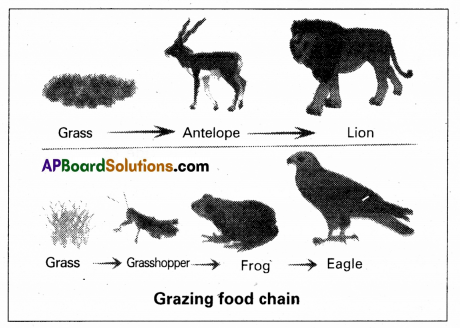
i) Grazing food chain: It is also known as predatory food chain, it begins with the green plants (producers) and the second third and fourth trophic levels are occupied by the herbivores, primary carnivores and secondary carnivores respectively. In some food chains, these is yet another trophic level – the climax car-n ivores. The number of trophic levels in food chains varies form 3 to 5 generally. Some examples from grazing food chain (GFC) are given below.
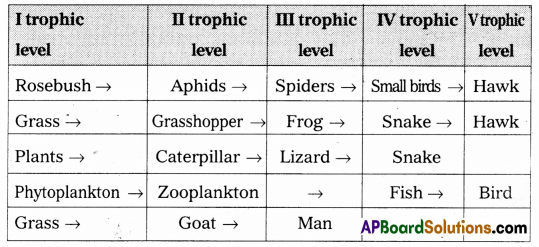
ii) Parasitic food chain: Some authors included the Parasitic Food Chains as a part of the GFC. As in the case of GFCs, it also begins with the producers, the plants (directly or indirectly). However, the food energy passes from large organisms to small organisms in the parasitic chains. For instance, a tree which occupies the 1st trophic level provides shelter and food for many birds. These birds host many ectoparasites and endo parasites. Thus, unlike in the predator food chain, the path of the flow of energy includes fewer, large-sized organisms in the lower trophic levels and numerous, small-sized organisms in the successive higher trophic levels.
iii) Detritus Food Chain: The detritus food chain (DFC) begins with dead organic matter (such as leaf litter, bodies of dead organisms). It is made up of decomposers which are heterotrophic organisms, mainly the ‘fungi’ and bacteria’. They meet their energy and nutrient requirements by degrading dead organic matter or detritus. These are also known as saprotrophs (sapro: to decom-pose).
Decomposers: Secrete digestive enzymes that break down dead and waste materials (such as faeces) into simple absorbable substances. Some examples of detritus food chains are:
- Detritus (formed from leaf litter) – Earthworms – Frogs – Snakes.
- Dead animals – Flies and maggots – Frogs – Snakes.
In an aquatic ecosystem, GFC is the major ‘conduit’ for the energy flow As against this in a terrestrial ecosystem, a much larger fraction of energy flows through the detritus food chain than through the GFC. Detritus food chain may be connected with the grazing food chain at some levels.
Some of the organisms of DFC may form the prey of the GFC animals. For example, in the detritus food chain given above, the earthworms of the DFC may become the food of the birds of the GFC. It is to be understood that food chains are not ‘isolated always.